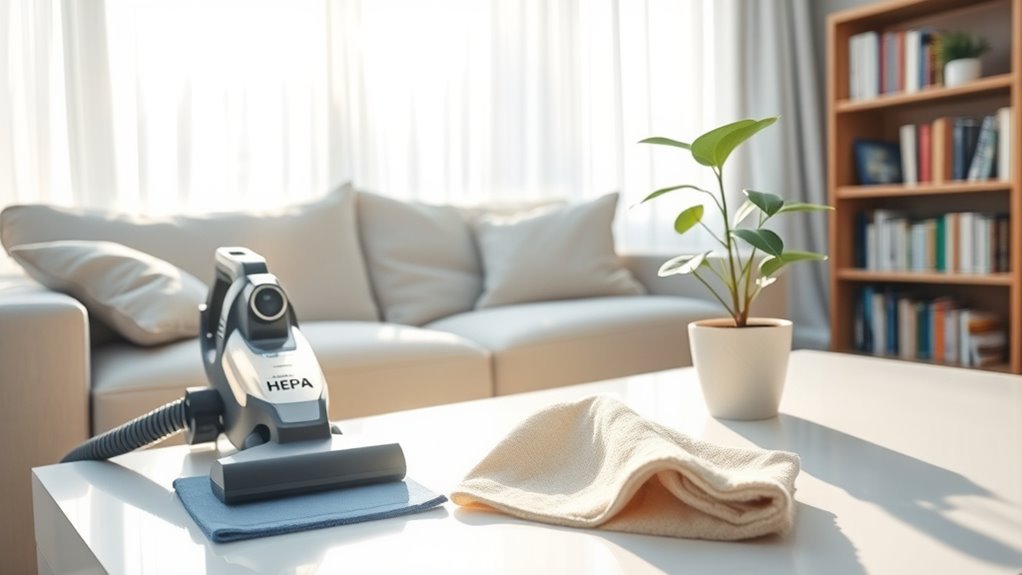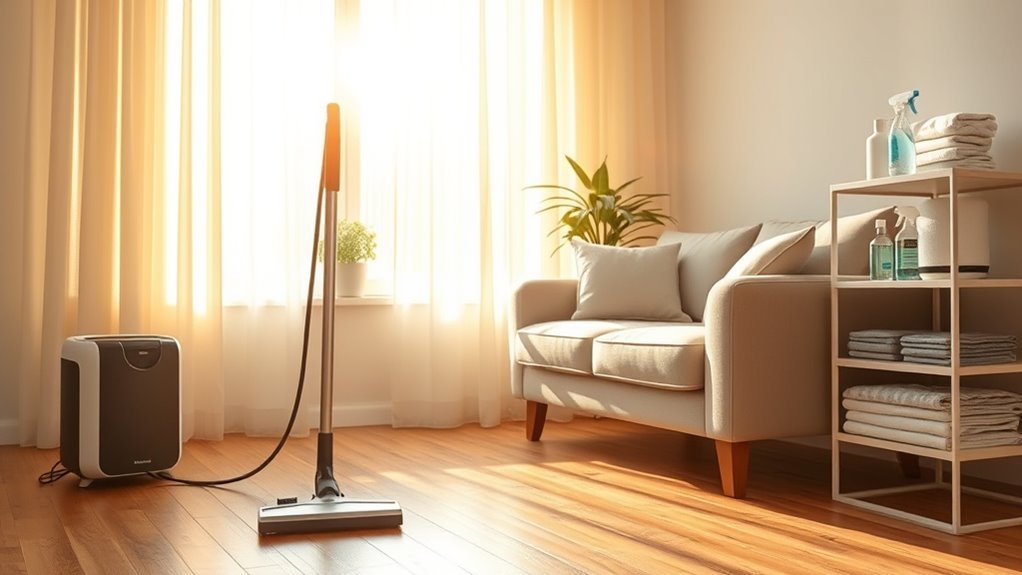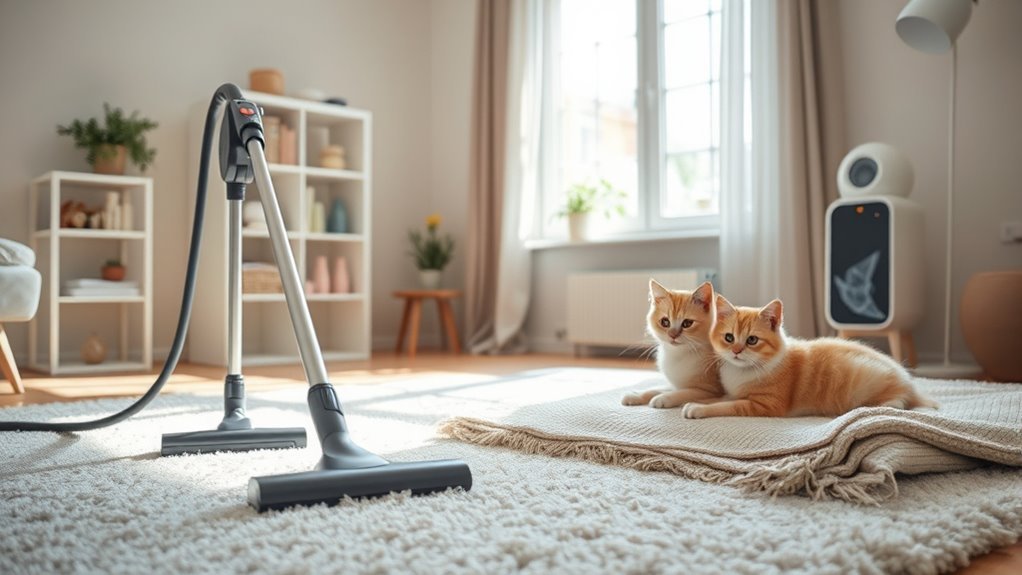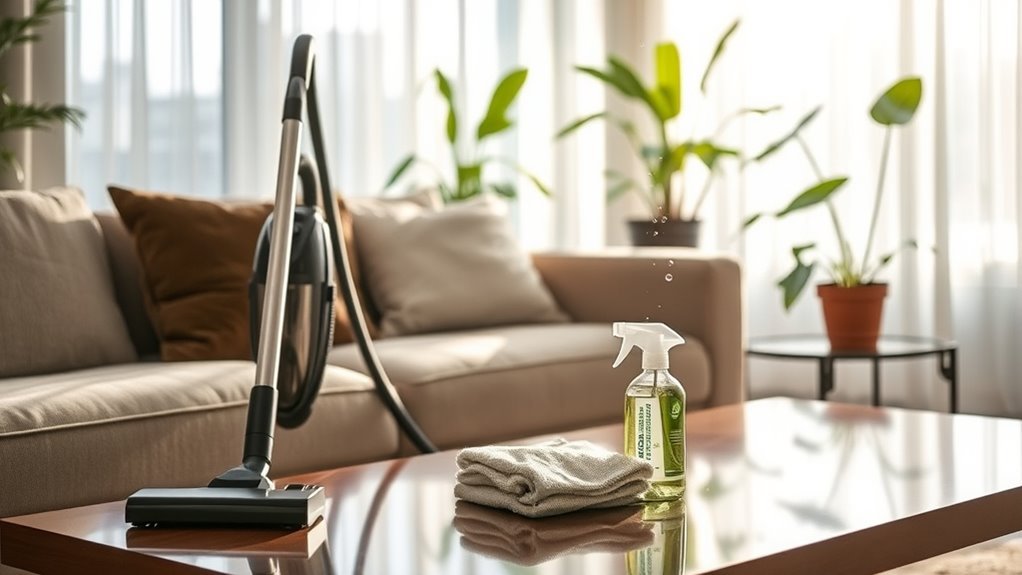Cleaning Tips for Homes With Asthmatic Residents
To keep your home asthma-friendly, control humidity between 30-50% to prevent mold and dust mites, and fix leaks promptly. Use natural, fragrance-free cleaning products to avoid irritating chemicals. Vacuum regularly with a HEPA-filtered vacuum and dust often to reduce allergens. Create pet-free zones and wash pet bedding weekly to limit dander. Ventilate while cleaning and maintain a regular schedule to keep allergens low. With these basics down, you can explore more ways to make your space even safer.
Identifying Common Asthma Triggers in the Home

There are several common asthma triggers you should watch for in your home to keep the air safe and comfortable. You’ll want to identify common allergens like dust mites, pet dander, mold spores, and pollen that often hide in carpets, upholstery, and bedding. Keeping indoor humidity between 30-50% helps prevent mold growth and dust mite proliferation, both of which worsen asthma symptoms. You can use a dehumidifier or air conditioner to control moisture levels. Also, be mindful of areas where moisture collects, such as bathrooms and kitchens, since excess humidity encourages allergens’ growth. By recognizing and managing these triggers, you reclaim your space and breathe easier, giving yourself the freedom to enjoy your home without fear of asthma flare-ups.
Choosing Asthma-Friendly Cleaning Products
Since harsh chemicals can worsen asthma symptoms, choosing the right cleaning products is essential for maintaining a safe home environment. You’ll want to opt for natural alternatives that avoid synthetic fragrances and harsh ingredients. These choices reduce irritants that can trigger asthma attacks, giving you more freedom to breathe easy. Fragrance free options are especially important since many scented products release volatile organic compounds that aggravate asthma. Look for labels that clearly state “fragrance free” or “unscented,” and check ingredient lists to avoid hidden chemicals. You don’t have to sacrifice cleanliness for health—natural alternatives can be just as effective without risking your respiratory comfort. By selecting asthma-friendly products, you create a cleaner, safer space where everyone can enjoy freedom from triggers.
Effective Dust Control Strategies

To keep dust from triggering asthma symptoms, you’ll want to vacuum regularly using a machine with strong suction and a HEPA filter. Reducing clutter on surfaces makes dusting easier and cuts down on places dust can settle. Also, using HEPA air filters can help capture airborne particles and improve indoor air quality.
Regular Vacuuming Techniques
Although vacuuming might seem straightforward, using the right techniques can make a big difference in reducing dust and allergens in your home. To keep asthma triggers at bay, maintain a consistent vacuuming frequency—ideally two to three times a week, especially in high-traffic areas. Choose a vacuum with a HEPA filter to trap fine particles effectively. When vacuuming, move slowly and overlap each stroke to lift more dust, and don’t forget upholstery and curtains. Empty the vacuum bag or canister outdoors to prevent dust from escaping back inside. By mastering these vacuuming techniques, you’re not only cleaning but reclaiming your space, creating an environment where you and your loved ones can breathe freely and live without restrictions.
Minimizing Clutter Surfaces
Many surfaces in your home can quickly become dust magnets, especially when cluttered with items. To keep asthma triggers at bay, adopting effective decluttering strategies is key. Start by regularly sorting through belongings and removing unnecessary objects that gather dust. Use organizing tips like clear storage bins or labeled boxes to keep essentials tidy and easily accessible. Keeping surfaces minimal not only makes cleaning faster but also reduces dust accumulation considerably. Remember, less clutter means fewer places for dust to settle, giving you freedom to breathe easier at home. By maintaining a streamlined space, you’re actively controlling dust without extra effort, creating a healthier environment that supports your wellbeing and comfort.
Using HEPA Air Filters
One of the most effective ways you can reduce airborne asthma triggers is by using HEPA air filters. These filters trap tiny particles like dust, pollen, and pet dander that standard filters often miss. By improving your home’s air quality, HEPA filters give you the freedom to breathe easier and feel more comfortable indoors. You can place portable HEPA air purifiers in bedrooms or common areas to target specific spaces where allergens tend to accumulate. Just remember to maintain and replace the filters as recommended to keep them working efficiently. Investing in HEPA filters is a smart move that helps you control dust and allergens without constant cleaning, giving you more time to enjoy your home without worry.
Managing Pet Dander in Shared Spaces

Keeping pet dander under control in shared spaces can be challenging but is essential for asthmatic residents. You want to enjoy your home freely without constant sneezing or wheezing. Start by establishing pet free zones where allergens won’t roam freely. Regular grooming techniques, like brushing your pet outdoors, greatly reduce dander inside. Here are other tips to keep pet dander at bay:
- Vacuum frequently using a HEPA filter vacuum cleaner
- Wash pet bedding weekly in hot water
- Use washable slipcovers on furniture
- Air out rooms daily to disperse airborne allergens
- Keep pets off soft furnishings and beds
Preventing Mold Growth and Removing Mold Safely
To keep mold from taking hold in your home, you’ll want to control moisture and improve ventilation. If you do find mold, it’s important to remove it safely using proper cleaning methods and protective gear. Let’s explore how you can prevent mold growth and handle any mold problems without risking your health.
Mold Prevention Strategies
Mold growth can be a major trigger for asthma symptoms, so controlling moisture is key to prevention. To keep mold spores at bay and enjoy a healthier home, focus on reducing dampness and improving air flow. Here’s how you can take charge:
- Fix leaks promptly to stop water from accumulating.
- Use dehumidifiers to maintain indoor humidity below 50%.
- Ventilate bathrooms and kitchens with exhaust fans.
- Clean and dry wet areas within 24-48 hours.
- Choose mold-resistant products for areas prone to moisture.
Safe Mold Removal Methods
Removing mold safely requires careful attention to protect both your health and your home. You can opt for natural mold solutions like vinegar or baking soda to clean small patches, keeping your space chemical-free and safe for asthmatic residents. However, when mold spreads extensively, professional mold remediation is the best choice to guarantee thorough removal without risking your freedom to breathe easy.
| Emotion | Action | Result |
|---|---|---|
| Concern | Use natural mold solutions | Safer indoor air |
| Empowerment | Wear protective gear | Personal safety |
| Relief | Call professionals | Permanent mold removal |
Taking control with safe methods lets you reclaim your home’s comfort and your freedom to live without worry.
Ventilation Tips to Improve Indoor Air Quality
Although improving ventilation might seem straightforward, it’s essential for reducing asthma triggers in your home. You want fresh air flowing freely to lower indoor humidity and flush out pollutants, empowering you to breathe easier. Embracing natural ventilation is a simple way to reclaim your space’s purity without feeling confined.
Here’s how you can boost your home’s air quality:
- Open windows and doors whenever possible to invite natural ventilation.
- Use exhaust fans in kitchens and bathrooms to remove excess moisture.
- Avoid blocking vents and air pathways to keep air circulating.
- Monitor indoor humidity; keep it between 30-50% to prevent mold growth.
- Incorporate houseplants that improve air quality but choose low-pollen varieties.
Using HEPA Filters and Air Purifiers
When you want to reduce airborne allergens and irritants, using HEPA filters and air purifiers can make a significant difference in your home’s air quality. HEPA filter benefits include capturing at least 99.97% of particles as small as 0.3 microns, which helps trap dust, pollen, pet dander, and mold spores that can trigger asthma. Choosing the right air purifier type matters—options like portable units, whole-house systems, and those with activated carbon layers offer various advantages depending on your home’s needs. By integrating these devices into your living space, you regain control over the air you breathe, making it cleaner and safer without feeling confined. This simple step supports your freedom to live comfortably despite asthma challenges.
Cleaning Carpets, Upholstery, and Curtains Safely
Since carpets, upholstery, and curtains can trap dust, pet dander, and other asthma triggers, you’ll want to clean them carefully to avoid stirring up allergens. Steam cleaning is a fantastic option—it kills dust mites without harsh chemicals, giving you a fresh, allergen-free space. For upholstery maintenance, vacuum regularly using a vacuum with a HEPA filter to capture fine particles. Also, consider these tips:
- Choose washable curtains and clean them often
- Spot-clean spills immediately to prevent mold
- Use allergen-proof covers on upholstered furniture
- Air out items when possible to reduce moisture
- Avoid aerosol sprays that can irritate your lungs
Taking these steps lets you breathe easier while enjoying your home freely and comfortably.
Establishing a Regular Cleaning Schedule
To keep asthma triggers under control, you’ll want to stick to a regular cleaning schedule that fits your lifestyle. Decide on cleaning frequency based on your home’s needs—high-traffic areas may require weekly attention, while less-used spaces can be cleaned biweekly or monthly. Setting a consistent routine helps prevent allergen buildup without overwhelming your day. Don’t hesitate to use task delegation to lighten your load; sharing responsibilities with family members or roommates guarantees the job gets done while giving you more freedom. Prioritize tasks that directly impact air quality, like vacuuming with a HEPA filter and dusting surfaces. By balancing frequency and delegation, you maintain a healthier environment effortlessly, freeing you to focus on what matters most.
Reducing Chemical Exposure During Cleaning
Because harsh chemicals can trigger asthma symptoms, it’s important you choose cleaning products carefully. Opting for natural alternatives and fragrance free options helps keep your home safe and breathable. You don’t have to sacrifice cleanliness for your freedom to breathe easy. Here’s how to reduce chemical exposure during cleaning:
Choosing natural, fragrance-free cleaning products helps keep your home safe and asthma-friendly without compromising cleanliness.
- Use vinegar and baking soda for scrubbing instead of harsh detergents
- Select fragrance free options to avoid irritants in the air
- Open windows or use fans to ventilate while cleaning
- Wear gloves to protect your skin from any irritants
- Avoid aerosol sprays; choose pump bottles or wipes instead
Frequently Asked Questions
Can Certain Foods Worsen Asthma Symptoms at Home?
Yes, certain foods can act as food triggers and worsen your asthma symptoms at home. Common culprits include dairy, sulfites, and processed foods, which may increase inflammation or cause allergic reactions. By making dietary changes—like avoiding these triggers and focusing on fresh, whole foods—you can help reduce flare-ups and breathe easier. You’ve got the freedom to choose what fuels your body, so listen to it and adjust your diet accordingly.
How Does Humidity Affect Asthma Indoors?
You might feel like your lungs are hosting a rainforest every time humidity spikes indoors! High humidity fuels mold growth, turning your home into an asthma trigger zone. But don’t worry—you can take charge by mastering humidity control. Keeping moisture levels balanced helps prevent mold and keeps your breathing free and easy. So, grab a dehumidifier or open those windows—it’s your move toward a fresher, asthma-friendly space!
Are Essential Oils Safe for Asthmatic Residents?
You might think essential oils are a natural way to freshen your space, but they can actually be asthma triggers for many people. If you have asthma, it’s best to be cautious because some oils release strong fumes that irritate your lungs. Instead of risking a flare-up, consider other freshening methods that don’t compromise your freedom to breathe easy, like good ventilation or hypoallergenic air purifiers.
What Role Does Stress Play in Asthma Attacks?
Stress plays a big role in asthma attacks because it can worsen your symptoms and make breathing harder. When you’re stressed or anxious, your body reacts, sometimes triggering an attack. That’s why stress management is key—you need to find ways to stay calm and avoid anxiety triggers. By keeping your mind relaxed, you give yourself more freedom to breathe easy and enjoy life without constant worry about asthma flaring up.
Can Houseplants Help Improve Air Quality for Asthma?
Imagine your home as a bustling city, with air purifying plants acting like diligent gardeners cleaning the streets. By embracing indoor gardening, you’re inviting these green allies to filter toxins, boost oxygen, and create a fresher atmosphere. While they’re no magic cure for asthma, these plants can help improve air quality, giving you a breath of freedom. Just choose varieties known for air purification to truly let your space thrive.






